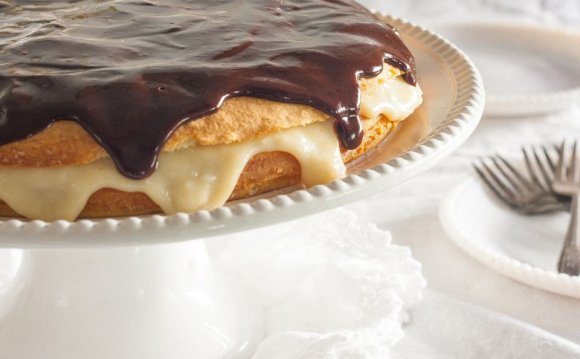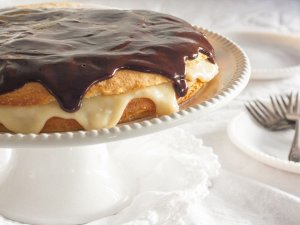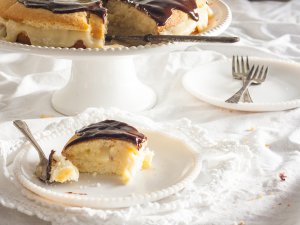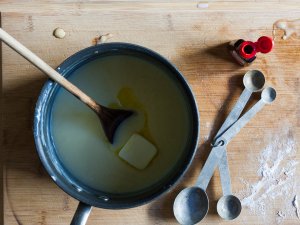
 whenever I ended up being a young child, Joe, we used to have a dream. I became locked up in a single day in a pastry shop, and there was treats all-around. There was clearly jelly rolls, and mocha eclairs, and sponge cake and Boston cream pie.
whenever I ended up being a young child, Joe, we used to have a dream. I became locked up in a single day in a pastry shop, and there was treats all-around. There was clearly jelly rolls, and mocha eclairs, and sponge cake and Boston cream pie.
—Daphne (played by Jack Lemmon) in movie Some want it Hot (1959)
Boston lotion pie– not a cake, maybe not ointment, and probably not from Boston. Boston cream pie consists of two layers of either yellow butter cake or sponge-cake sandwiched with vanilla pastry ointment and topped with a soft chocolate glaze. The combo of dessert and pastry lotion filling goes a century and a half. The now standard covering, however, is a somewhat belated addition as, before late 1940s, the cake was typically bare or just sprinkled with confectioners’ sugar. Because of the affixing regarding the chocolate glaze, Boston cream cake turned into one of America’s best known and favorite snacks.
Boston lotion pie is commonly (and wrongly) attributed to an inspired cook at Boston’s Parker House, just who purportedly around the hotel’s opening in 1855 developed a European-style torte by distributing light vanilla custard inside two genoise-type dessert layers and topping all of it with a chocolate icing. (The modern type of Boston lotion pie prepared by the Omni Parker home consist of ten-inch circular sponge-cake filled with a rum-accented pastry ointment, only a little extra pastry ointment scatter in the edges, toasted cut almonds pressed around the sides, and topped with semi-sweet chocolate fondant with white fondant piped in spirals within the chocolate.) But no 19th-century or very early 20th-century origin (like the Parker home) ever pointed out a connection amongst the Parker House and a chocolate-topped custard-filled cake. “Cream Pie” showed up on the Parker home menu around 1870, the same time the dish became widely popular in the us, nevertheless term “Parker home Chocolate Cream Pie, ” one with a chocolate topping, would not appear on its menu until 1957. (For lots more in the Parker home, see: Parker House Rolls)
Another extensive misnomer attributes initial record of Boston ointment cake to articles within the December 24, 1855 problem of the newest York Herald given that dessert when it comes to semi-centennial anniversary gathering of the New England community. But that origin mentioned “Boston Cream Cakes, ” which was really the 19th century appellation for cream puffs – then only recently introduced to America. the very first imprinted record regarding the term “Boston Cream Cakes” was at the “appendix containing new receipts” when you look at the 1844 version of Directions for Cookery by Eliza Leslie (Philadelphia, web page 458) -— this recipe absent from earlier in the day versions. Leslie directed: “whenever done, remove them, and open within the part of every (while very hot) a slit or cut, adequate to admit a portion of custard which has been created for them.” Leslie utilized baked custard to fill her puffs. Temperance cookbook by Mary Smith (San Jose, 1887) explained about “Boston Cream Cakes, ” which by that point were filled up with pastry cream: “They will undoubtedly be hollow inside.”
the very first imprinted record regarding the term “Boston Cream Cakes” was at the “appendix containing new receipts” when you look at the 1844 version of Directions for Cookery by Eliza Leslie (Philadelphia, web page 458) -— this recipe absent from earlier in the day versions. Leslie directed: “whenever done, remove them, and open within the part of every (while very hot) a slit or cut, adequate to admit a portion of custard which has been created for them.” Leslie utilized baked custard to fill her puffs. Temperance cookbook by Mary Smith (San Jose, 1887) explained about “Boston Cream Cakes, ” which by that point were filled up with pastry cream: “They will undoubtedly be hollow inside.”
The origins of Boston lotion cake put during the early 19th century level cakes (the second term only promising within the 1870s) initially referred to as jelly cakes. In the nation’s first rudimentary layer cakes, cooks distribute jelly or jam between dessert rounds, stacked them, and slashed it into wedges like a pie. That offered increase to an earlier synonym for jelly dessert – Washington cake. (different then Washington dessert.) As opposed to jelly, cooks sometimes substituted a thick velvety blend made by boiling sugar and heavy cream until syrupy, after that beating it until cooled – initially still known as jelly cake despite another filling. By the mid-1860s, versions of jelly dessert using lighter pastry lotion showed up. Pastry cream is a stovetop custard with a smooth and soft texture – possesses some starch – that makes it spreadable, yet firm adequate to stay in a cake. 1st record in English of “Crême Patissière-—(Pastry Cream)” was in the 1829 version regarding the French Cook by Louis Eustache Ude (London). The meal fundamentally made its way across the Atlantic and into United states cakes variously presuming the names “custard dessert, ” “cream pie, ” and “Washington pie.”




YOU MIGHT ALSO LIKE











